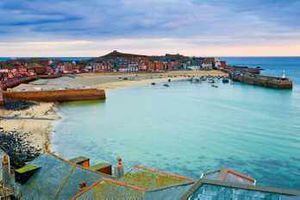Wizards of odd
There's disappointment all round for Tim Earl on his latest exploration, which involves not-so-pretty beauty spots, an absence of art and an unimpressive Eden Project. But despite discovering the odd gem, our columnist is left confused by Cornwall...

CORNWALL is a strange sort of place.
Miles from anywhere civilised, it is out on a limb, a quirky county beyond England. As a would-be country – it has its own flag – the Cornish people are independent in character but distinctly odd.
Take Land's End, for example. It should be a beauty spot, with cliffs and views looking out on the world beyond our shores, wild and natural – the last place on Earth for stay-at-home Brits. But it is not.
Follow the A30 down to its conclusion and one is greeted with signs saying 'free entrance'. A little further on, the small print explains that you pay £5 to park the car and then it's free.
Free, that is, until you walk through the shops and think about visiting Journey to the Centre of the Earth or Prehistoric Monsters of the Deep: 'Come face to face with some of the largest and most fearsome creatures the Earth has ever seen – dinosaurs, plesiosaurs, even giant squid are brought to life in this exciting virtual exhibition... Wonder at the amazing hunters that still inhabit the waters off Land's End today – the sharks!'
Er, not quite. The sharks are on land, waiting to take a tenner a head from folk who are sucked in by the advertising boards (and hordes are taken in daily).
If, like me, you choose to wander the cliff-top along roped-off paths that lead to well-worn lookout spots, the eye is drawn to a small cottage and outhouses 200 metres from the main centre.
Greeb Farm is believed to have been home to mankind since the Mesolithic Age. It is a pretty ordinary house, the outside of which is rather spoiled by duck droppings, a 'charity wishing well', a tiny pottery and a converted stable that houses a jeweller (possibly descended from the Mesolithic folk) and a leather craftswoman (actually, her skin looked quite soft).
The jeweller and leather lady seem to take turns with a glass engraver and a woodturner, who were absent on my visit, although the other two sold their wares for them.
No, the English end of the British mainland is a rather seedy place and one has to wonder what the Americans and Japanese make of it all.
Wildlife was present: a herring gull perched on a stone eagle's head, jackdaws thronged the site and a whimbrel flew over, calling forlornly.
*
It was better at the Lizard, where Cornish choughs feed in the sheep-cropped fields on top of Britain's most southerly point. Jackdaws and gulls are there, too, with a couple of shags on a sea-stack.
The cliffs – and lanes that wind around them – are reminiscent of Guernsey, made the more so by the sighting of a grey seal in the sea below.
But this other go-no-further spot is also commercialised with private pay-and-display car parks (which give threats of clamping and tow-away) or others provided by the National Trust with honesty boxes for 'donations'. (I dropped in a £2 coin, honestly.)
An excellent cafe serves the most delicious home-made food, including Cornish clotted cream teas, but it has only a staff loo – patrons are advised to return to the pay-and-display car park, where there is a pay-and-do-not-display lavatory.
(Happily, the cafe's patron allowed my elderly companion to use the staff loo – 'But don't flush unless you have to,' she said. I never did find out why, but thank you, madam, anyway.)
One can drive from the West Country's south coast to its north coast in just 25 minutes. We returned to our St Ives hotel in that time and reminisced about our afternoon while gazing out into the Irish Sea. (Perhaps that should be the Bristol Channel?)
St Ives is delightfully quaint and has rejected the car. Most people get around using park-and-ride schemes or the cheap taxis. Guernsey cabbies take note: cheap and busy rather than expensive and never there when the airport is busy.
The town is pretty and is given character by the hills upon which it is built, offering fabulous views over the rooftops to three stunning sandy bays. Two of these are used by surfers, depending on the wind direction.
The houses have steep eaves – possibly to cope with heavy winter rain – which lend great character to the rooftop views.
*
Good shops and friendly, helpful people make St Ives a gem of a town.
In addition, it is home to Tate St Ives.
It is a rather odd gallery because of its four floors, only one of which is home to modern art. The others house the entrance and ticket desk (first floor), shop (second) and a cafe and terrace on the fourth.
This is a shame, as the modern art (which I usually hate) was rather interesting.
I liked a completely white room, on the walls of which had been marked the height and first name of every visitor this summer. There must have been many, but my companion and I still made our mark on the piece.
Canvases decorated with driftwood rather than oils were fun, as was the quirky art of Italian Lucio Fontana, who described his work as spacialism. He added holes to canvases and bronze sculptures, each of which was named, confusingly, Spacial Concept.
An 'iconic work' by Martin Creed – Half the Air in a Given Space – fills a sea-facing gallery with hundreds of white balloons. People walk through the display, some completely submerged, others with heads and shoulders above the sea of balloons.
I wondered if any participants had been alert enough to look beyond the gallery to see St Ives's surfers in the waves below, some submerged, others with just their heads and shoulders showing.
*
The last odd place visited on my short trip was the disappointing (to me at least) Eden Project.
Impressive when looked upon on arrival, it lost its way quickly with mixed and confused collections of plants in the domes (rainforest and Mediterranean habitats) and outside (Cornish wildlife planted up with exotics from all over the world).
The cafes were equally confusing and we came away hungry in both spirit and bellies. All I learned was that the Eden Project is an educational gardening charity, but what its aims were I am at a loss to answer.
Breakfast on our last morning before driving back to civilised Sussex was the 'full Cornish'. It seems that nothing English thrives among the Cornish exotics at the end of the land.





